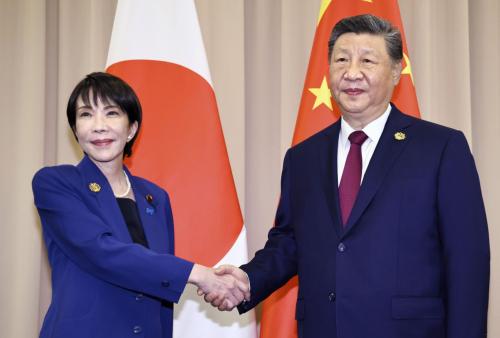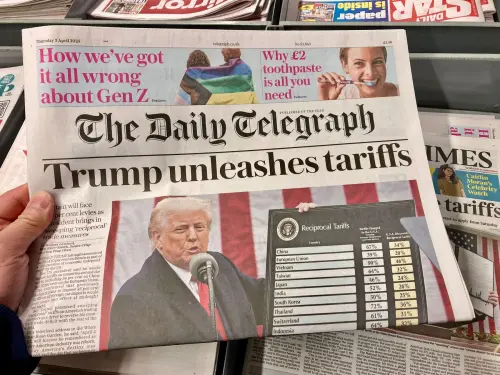This article is a summary of the discussion at a Brookings event held on April 3, 2025. You can watch the full event video here.
The 20th century generally saw a rise in global trade liberalization and a decline in the use of tariffs. Now, after two presidential terms of elevated tariffs, the second Trump administration has undertaken a dramatic next step—measures that Brookings Vice President and Director of the Economic Studies program Ben Harris called, “one of the most consequential economic policy changes of my lifetime,” at an event on April 3, 2025, hosted by the Brookings Institution.
The event, “Trump’s reciprocal tariffs: What are they? How will they work?” featured an introduction from Harris followed by a panel discussion with former Deputy United States Trade Representative Sarah Bianchi (Evercore), Mary Lovely (Peterson Institute for International Economics), and former Deputy Assistant to the President for International Economic Affairs Kelly Ann Shaw (Hogan Lovells). The panel was moderated by Ana Swanson of the New York Times. Below are key takeaways from the event.
A “seismic” shift in US trade relations around the world
Opening the panel discussion, Shaw provided an overview of Trump’s latest tariff actions: a universal, baseline tariff of 10% to all U.S. trading partners (with exceptions for certain products) and individualized, reciprocal tariffs for about 60 countries. Importantly, Shaw noted that early comments from the Trump administration suggest that these tariff hikes represent an “opening offer” and that she expects them to evolve in the coming weeks, months, and even years.
We're a country that is governed by law, not by deals.
Mary Lovely, Peterson Institute for International Economics
In terms of how countries will respond to this opening offer, Bianchi noted that many of the Trump administration’s concerns are not just about foreign tariff rates on American products but rather more structural issues—in Vietnam, high levels of Chinese investment, or in Europe, regulation and digital taxes. The question of whether these structural changes can be made and how long it will take will be major points of uncertainty for markets and consumers, Bianchi said. Further, Lovely added her concern about the deal-making approach to trade policy: “We’re a country that is governed by law, not by deals,” she said. “I think it is a bipartisan issue about how we run our government, and basically how arbitrary trade policy opens up avenues for corruption.”
What does “reciprocal” really mean?
Lovely immediately brought attention to the term “reciprocal,” which the Trump administration has used to justify the individualized tariffs, ranging from 11-50% of the cost of the good being imported. “There is nothing reciprocal about this … It’s a complete misnomer,” she said. She explained that the methodology the Trump administration used to calculate tariff rates was based on a percentage of the equivalent structural barriers in the target country. “As a technical economist, I can tell you there’s really no methodology there. It is basically taking the trade deficit and dividing it by the value of their exports,” she explained.
Shaw noted, in terms of justification, the individualized, reciprocal tariffs are targeted at countries where the U.S. faces an “uneven playing field,” which the tariffs are meant to level. For the broader tariffs, the Trump administration has argued that there is a need to secure supply chains for times of national security crisis, as well as address the trade deficit, Shaw explained. This mix of goals complicates the issue considerably, Bianchi noted, on both the legal side and explaining the tariffs to the public. “I think the challenge is, President Trump uses tariffs for so many different reasons that it is very, very hard to follow.”
Will the new tariff regime achieve the Trump administration’s goals?
Lovely argued a significant majority of macroeconomists agree these tariffs will not reduce America’s trade deficit, which are the result of an imbalance between U.S. spending and income. “It could trigger a recession, in which case we will see the trade deficit close, because our consumption will fall,” she said. “That’s really not the policy that anybody, I’m sure, even including the Trump administration, wants to see.”
To Lovely, a glaring problem is the lack of a clear, sustainable strategy for how these tariffs will secure supply chains and return manufacturing to the U.S. Manufacturing jobs moved abroad because they were low-paying, low-skill positions, she explained, and recent U.S. policies encouraged the development of those industries outside of China. “That was a good thing, that was building resilience and reducing dependence on China,” she said. But Trump’s new tariffs target many of those countries. Further, Bianchi added that the tariffs could “give China an opportunity to make real inroads in these other countries.”
Shaw noted that, from the perspective of the administration, tariffs aren’t the only approach being used to pursue their goals. “You have to take the entirety of the economic plan and not just cherry pick out one piece of it, even if that piece is huge,” she said. And on the national security/China question, Shaw said she felt U.S. relationships with trade partners will continue to develop in the coming months. “I think this is going to be put back together,” she said, “but in a very different way than we’ve seen.”
For more on de-risking from China, tariff enforcement, and industry response to the tariffs, watch the full event video below.
The Brookings Institution is committed to quality, independence, and impact.
We are supported by a diverse array of funders. In line with our values and policies, each Brookings publication represents the sole views of its author(s).




Commentary
Key takeaways on Trump’s reciprocal tariffs from recent Brookings event
April 8, 2025